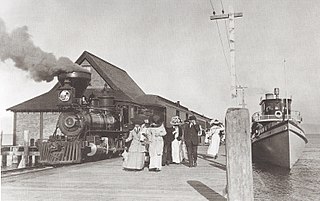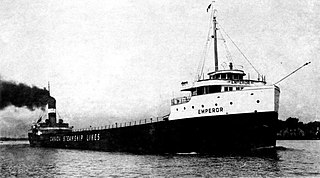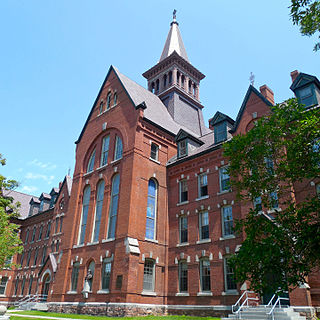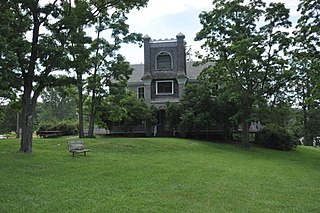
The Lake Champlain Transportation Company provides car and passenger ferry service at three points on Lake Champlain in the United States. From 1976 to 2003, it was owned by Burlington, Vermont, businessman Raymond C. Pecor Jr. who is Chairman of the company's board. In 2003, he sold the company to his son, Raymond Pecor III.

SS Tahoe was a steamship that operated on Lake Tahoe at the end of the 19th century and the first half of the 20th. Scuttled in 1940, the wreck presently lies in 400 feet (120 m) of water off Glenbrook, Nevada. The wreck was first visited in 2002 by a team from New Millennium Dive Expeditions (NMDE) in a record-setting high-altitude dive for Lake Tahoe. As a result of the work that NMDE did on the Tahoe site from 1999 up to their dives in 2002, Tahoe became the first maritime site in Nevada to be listed in the National Register of Historic Places.

The steamboat Ticonderoga is one of two remaining side-paddle-wheel passenger steamers with a vertical beam engine of the type that provided freight and passenger service on America's bays, lakes and rivers from the early 19th to the mid-20th centuries. Commissioned by the Champlain Transportation Company, Ticonderoga was built in 1906 at the Shelburne Shipyard in Shelburne, Vermont on Lake Champlain.

Oyster Bay is the terminus on the Oyster Bay Branch of the Long Island Rail Road. The station is located off Shore Avenue between Maxwell and Larabee Avenues. It is a sheltered concrete elevated platform that stands in the shadows of the original station, which was accessible from the ends of Maxwell, Audrey, and Hamilton Avenues. Both stations exist along the south side of Roosevelt Park.

The First Methodist Church of Burlington is a historic church located at 21 Buell Street in Burlington, Vermont. Built in 1869 to a design by Alexander R. Esty, it is the city's only example of ecclesiastical Romanesque Revival architecture. It was listed on the National Register of Historic Places in 1978.

The steamboat Oakes Ames was built in 1868 by the Napoleon B Proctor Shipyard in Burlington, Vermont for the Rutland Railroad. The 244-foot paddle wheeler was designed to ferry railroad cars from Burlington across Lake Champlain to Plattsburgh, New York. She was named after one of the railroad's directors' Oakes Ames.

The Cumberland was a wooden-hulled side paddlewheeler built in 1871; it was wrecked off the shore of Isle Royale in Lake Superior in 1877 and the remains are still on the lake bottom. The wreck was placed on the National Register of Historic Places in 1984.

The Emperor was a freighter built in 1910; it sank off the shore of Isle Royale in Lake Superior in 1947 and the remains are still on the lake bottom. The wreck was placed on the National Register of Historic Places in 1984.
The SS Homer was a sidewheel paddle steamer which plied the waters of the Mississippi River and its tributaries. Built in 1859 in Parkersburg, West Virginia, she was 148 feet (45 m) long, 28 feet (8.5 m) wide, and 5 feet (1.5 m) deep. Her first significant service was in 1860, when she was used as a packet steamer on the Red and Ouachita Rivers, under master and co-owner Samuel Applegate. In 1861, after the start of the American Civil War, she was contracted to the government of the Confederate States of America, and was used to transport men and war materiel. She was used to supply the defenders of Port Hudson, Louisiana, in 1864. That year she was captured by the Union Army forces of General Frederick Steele when she was about 30 miles (48 km) below Camden, Arkansas on the Ouachita River. Steele was at the time engaged in a major expedition whose goal was to reach Shreveport, Louisiana, but had stalled due to Confederate resistance and a lack of supplies. Steele had then occupied Camden, and it was during this occupation that the ship was taken, loaded with grain and other supplies. The Union forces piloted her back to Camden.

The Old Mill Building is the oldest campus building of the University of Vermont (UVM) and is located along the central eastern side of the "University Green" in Burlington, Vermont.

The Morgan Horse Farm is a historic horse breeding facility at 74 Battell Drive in Weybridge, Vermont. Since 1907, it has been an official breeding site for the Morgan horse, one of the first American-bred horse breeds, and Vermont's official state animal. The breeding program was established in Burlington in 1905, and moved to this site in 1907 by the United States Department of Agriculture, and is now run by the University of Vermont. The farm is listed on the National Register of Historic Places.

The Hawley's Ferry House, also known just as the Hawley House, is a historic house on the shore of Lake Champlain in Kingsland Bay State Park, Ferrisburgh, Vermont. Built about 1790, it is one of the few surviving 18th-century buildings on the Vermont side of the lake. It was listed on the National Register of Historic Places in 1978.

The Burlington Breakwater is a breakwater providing shelter to the harbor of Burlington, Vermont from the open waters of Lake Champlain. It was built in several stages between 1836 and 1890, and is a rare example of a 19th-century timber-cribbed stone breakwater. It was listed on the National Register of Historic Places in 2003.

The General Butler was a schooner-rigged sailing canal boat that plied the waters of Lake Champlain and the Champlain Canal in the United States states of Vermont and New York. Built in 1862 and named for American Civil War General Benjamin Franklin Butler, she sank after striking the Burlington Breakwater in 1876, while carrying a load of marble. Her virtually intact wreck, discovered in 1980, is a Vermont State Historic Site and a popular dive site; it was listed on the National Register of Historic Places in 1998.

The O.J. Walker was a cargo schooner that plied the waters of Lake Champlain between New York and Vermont. Built in 1862 in Burlington, Vermont, she hauled freight until sinking off the Burlington coast in a storm in 1895, while carrying a load of brick and tile. The shipwreck, located west of the Burlington Breakwater, is a Vermont State Historic Site, and is accessible to registered divers. It is one of the best-preserved examples of the 1862 class of sailing canal schooners, and was listed on the National Register of Historic Places in 1998.

The Phoenix was a sidewheel paddle steamer operating on Lake Champlain between the United States states of New York and Vermont and the British province of Lower Canada. Built in 1815, she grounded, burned and sank in 1819 off the shore of Colchester, Vermont. Her surviving wreckage is the oldest known example of a sidewheel steamer anywhere in the world. The wreck site is a Vermont State Historic Site, which may be visited by registered and qualified divers. It was listed on the National Register of Historic Places in 1998.

The Norman was a bulk freighter; its wreck in Lake Huron was listed on the National Register of Historic Places in 2016.
Josephine was an American iron-hull, sidewheel steamer that transported mail, freight, and passengers, in the Gulf of Mexico, mainly between New Orleans, Louisiana and Galveston, Texas, beginning in 1868. In 1881, the Josephine was transferred to the New Orleans – Havana route. Returning from Havana in February 1881, the Josephine encountered a winter storm in the Gulf of Mexico, south of Biloxi, Mississippi, took on water and sank, but all passengers and crew survived. In 2000, the Josephine shipwreck was listed on the National Register of Historic Places.

Grecian was a steel bulk freighter built in 1891 by Globe Iron Works at Cleveland, Ohio. She was a sister ship to Norman, also wrecked nearby. The ship was 296 feet (90 m) long, with a beam of 40 feet (12 m) and a gross register tonnage of 2,348 tons.

The SS Atlanta was a wooden hulled Great Lakes steamer that sank in Lake Michigan off the coast of Cedar Grove, Wisconsin, United States, after burning down. Her wreckage still remains at the bottom of the lake, and on November 6, 2017, the wreck of the Atlanta was listed on the National Register of Historic Places.

















